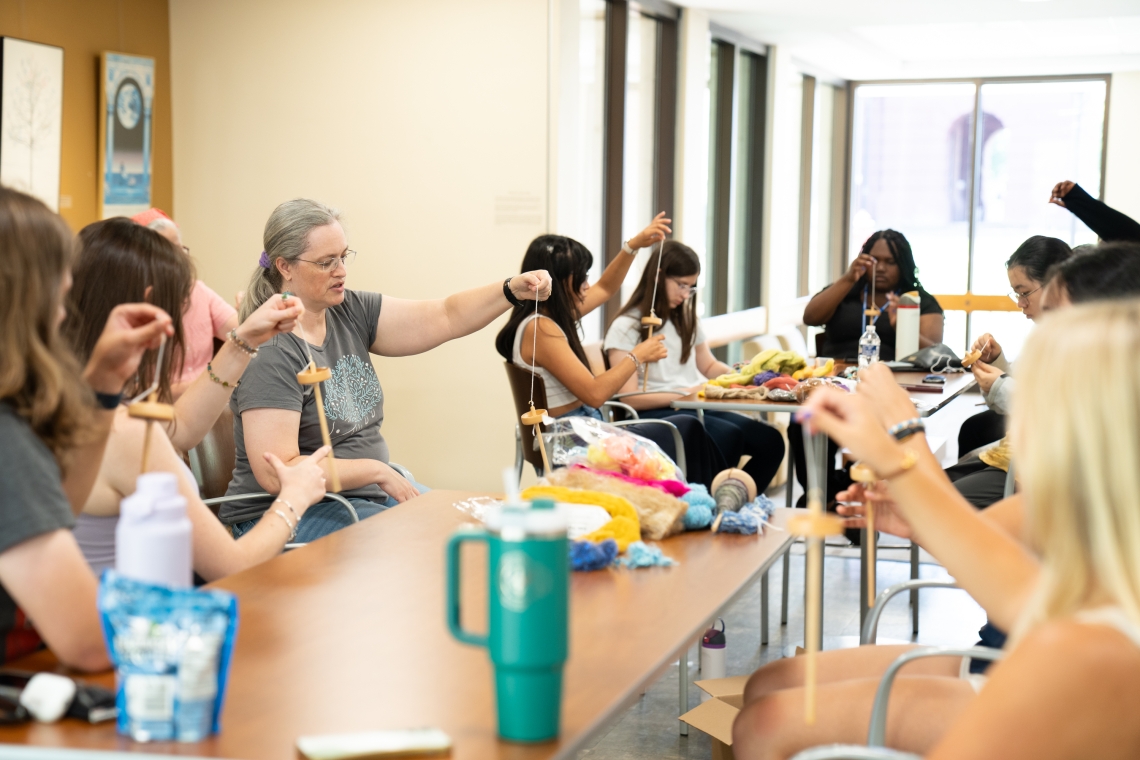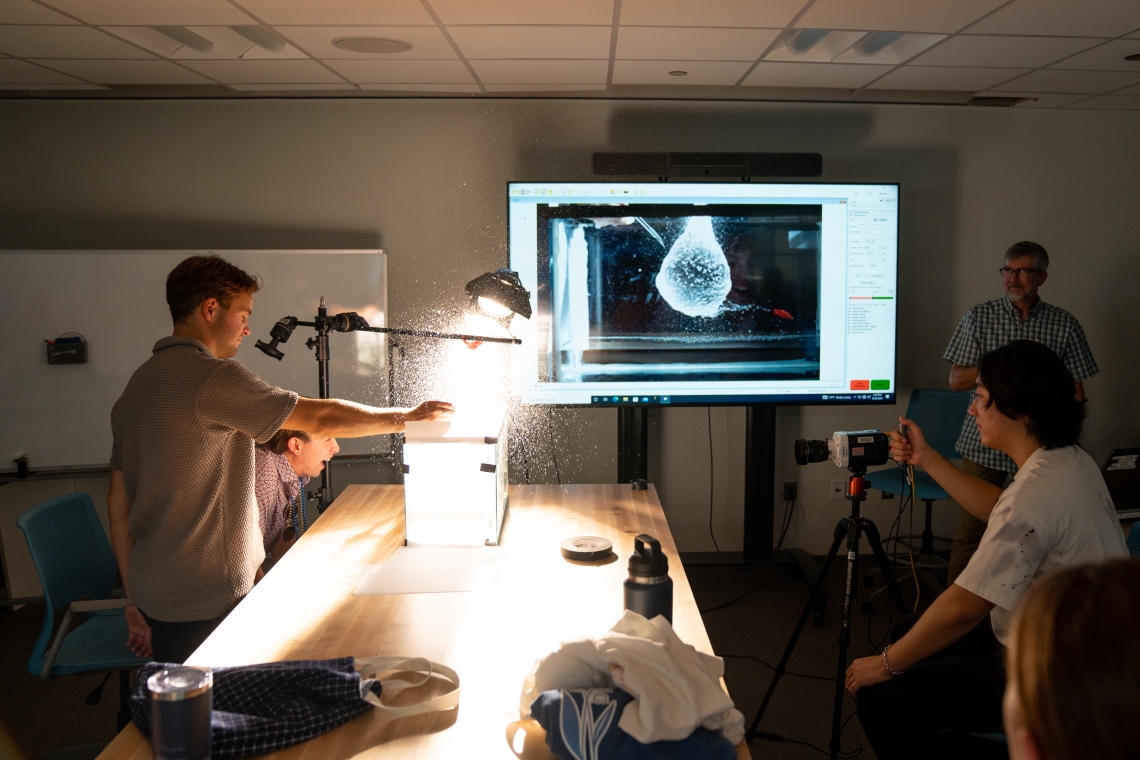
Hands-On Experience Students participating in two new Leading Edge programs during this year’s first-year orientation were able to complete tactile projects while building community on campus.
“This is a perfect example of something that can provide a very safe space for students to practice a growth mindset. You are going to make mistakes, and you are also going to learn how to adapt and improve. It’s a profound thing to learn at this stage of life.”
~ Katharine Shester, professor of economics
Tote bags, quilts, coffee mugs and a tiny woolen stuffed animal were just some of the finished products students could take away from two new Leading Edge experiences offered as part of W&L’s first-year undergraduate student orientation programming this year.
Incoming first-year students participating in Threads of Connection: Fiber Arts exploration, led by Julie Knudson, director of academic technologies, and K.T. Vaughan, Hal F. and Barbra Buckner Higginbotham University Librarian, received a crash course in crocheting, knitting and sewing. In the Designing and Making experience focused on the IQ Center (a state-of-the-art collaborative teaching and learning space that fosters interdisciplinary research where students can use a variety of equipment such as high-speed cameras, 3D printers and advanced research microscopes), students worked with Dave Pfaff, senior academic technologist and director of the IQ Center, and Mickie Brown ’21, academic technologist, on creating keychains and other items using a laser cutter, 3D-printed coffee mugs and a custom logo they could sew onto their own tote bags.
Leading Edge gives all first-year students an introduction to W&L and an opportunity to meet new friends before classes begin at no extra cost. The week-long experiences (students can choose from 13 different programs/trips, both on and off campus) are designed as bonding opportunities to engage with people from diverse backgrounds, learn about themselves and build the necessary skills to thrive in college. Knudson said the idea for a fiber arts-based Leading Edge offering was born out of her work with Pfaff and Brown last year to expand a makerspace within the IQ Center that would accommodate sewing workshops for students. She connected with fellow fiber artist Vaughan, who said she was inspired by a workshop she recently attended on using craft to teach data visualization. Vaughan added that the week’s topic and itinerary set the stage for various other substantive discussions with students.
“The fiber arts focus really allows us to talk about, for example, slow versus fast fashion and sustainability issues,” Vaughan said. “It allows us to talk about the economics of small businesses and farming. It also allows us to talk about the idea of creativity. Issues of gender, race and culture can come up in these discussions. There’s just so much that made it make sense to us as an academic enterprise as well as a chance to learn new practical skills.”
The fiber arts experience incorporated partnerships with several local businesses and organizations related to the fiber arts. The group met with Ellie Boylan, owner of House Mountain Yarn Company in Lexington, to learn about running a small business in the fiber arts. They visited The Quiltery in nearby Fairfield to pick out fabrics for their quilting projects. The group also visited an alpaca farm near Harrisonburg for a tour and a demonstration of natural wool dyeing. One of the group’s final projects included producing a quilt together that was donated to the Rockbridge SPCA to provide bedding for their kennels.
“I’m so happy I had the experience of trying sewing, quilting, crochet, knitting, embroidery and drop spindling,” said Ayame Merkel ’28, “because it gave me a refresher on the skills I knew previously and introduced me to others that might become lifelong hobbies. The skills are also very practical, like learning to use a sewing machine and creating different stitches by hand.”
Merkel, a Fair Haven, Vermont, native interested in majoring in music and education, added that the week elevated the fiber arts for her in a new way.
“I learned that there are so many areas within the fiber arts that don’t get a lot of recognition as fine art forms but certainly deserve it,” she said.
The fiber arts itinerary also connected students with many campus community members. Students spent time with Elisabeth Wislar, costume designer and costume shop manager in the theater department’s costume shop to learn more about her background and work. And avid quilter Katharine Shester, professor of economics, met with the group to introduce herself and consult on some of their projects. She said fiber arts are an excellent way for students to prepare for academic and personal challenges in college.
“This is a perfect example of something that can provide a very safe space for students to practice a growth mindset,” Shester said. “You are going to make mistakes, and you are also going to learn how to adapt and improve. It’s a profound thing to learn at this stage of life.”
Students spent their final morning together as a group with Dean of the College Chawne Kimber, a textile artist whose work has been acquired by the Smithsonian American Museum of Art.
“This can be a springboard into a lifetime of creative pursuits in the fashion of our foremothers,” Kimber said. “More importantly, the students bonded in mini-bees, encircling quilts created by their newly formed community and trading knowledge of crochet and knitting. These bonds will serve them well as they weave themselves into the fabric of the W&L campus.”
Knudson said that creating a sense of community surrounding fiber crafts on campus has been her goal for the makerspace from the very beginning and that Leading Edge provides another avenue for that.
“I think our intention is also to show how craft can fit into a life well lived,” Knudson added. “The creative arts are a great way to manage stress.”
Pfaff and Brown said they were pleased to have achieved a diverse gender balance for their Designing and Making trip focused on the IQ Center, noting that many STEM-focused activities and programs have been perceived as predominantly attracting male students. The goal for the week’s itinerary was to introduce students to the wide variety of ways they can access the IQ Center throughout their coursework at W&L.
“We wanted to introduce incoming students to the resources and technologies that we have here in the IQ Center and show them how professors are using those tools and technologies in both their classes and their research,” Pfaff said.
Faculty were invited to speak to the group about a specific technology, such as 3D printing, modeling or LIDAR (a remote sensing apparatus that uses light in the form of a pulsed laser to measure variable distances). George Bent, Sidney Gause Childress Professor in the Arts, visited the group to discuss the ongoing Florence As It Was project, for which he has collaborated with Pfaff and Associate Professor and Digital Humanities Librarian Mackenzie Brooks for several years. The IQ Center also hosted a virtual reality game night for the entire campus one evening, one of several activities held throughout the week that invited pre-season athletes who were unable to participate in Leading Edge to join in with other first-year students.
Trip leader Kelan Joiner ’27 said the highlight of Designing and Making was seeing first-year students’ senses of accomplishment when finishing a project.
“I believe that this trip was an amazing opportunity for more STEM-minded students to have an orientation experience that fits their interests and could provide them with several new skills that will be helpful during their time at W&L,” Joiner said. “I think it provided an engaging environment that attracts students with similar interests and passions, which allowed them to form friendships and get to know one another easily.”
Muhlenberg, Pennsylvania, native Tucker Bellanca ’28 said his Leading Edge experience reinforced why W&L was the right choice for him.
“One of the biggest reasons I wanted to come here was that this is a close, tight-knit community where I have the opportunity to try so many new things,” Bellanca said, adding that the faculty he met in the IQ Center had already piqued his curiosity to explore different classes as he is considering his future major.
Kim Hodge, associate dean of students, said this year’s Leading Edge program brought fresh energy to an already exciting time of the year.
“This year’s Leading Edge week very much felt that everyone connected with the purpose and joy of the program,” Hodge said. “First-year students really jumped into getting to know each other and the trip leaders. We saw friends run up and hug each other at the end of the week. We heard from seniors who had led trips for three years that this was the best year ever. The Leading Edge experience continues to inspire me and to be at the top of my favorite things I have done in my career. And the fact that the whole campus comes together for these incoming first-years is a testament to how we aspire to care for each other in this community.”
 Students in Thread of Connection learn new sewing techniques during the week-long orientation session.
Students in Thread of Connection learn new sewing techniques during the week-long orientation session. Vaughan and students practice spindling as a group.
Vaughan and students practice spindling as a group. Students try out the motion capture equipment in the IQ Center during the Designing and Making Leading Edge trip.
Students try out the motion capture equipment in the IQ Center during the Designing and Making Leading Edge trip. Students capture a water balloon exploding with a high-speed camera in the IQ Center.
Students capture a water balloon exploding with a high-speed camera in the IQ Center.
You must be logged in to post a comment.